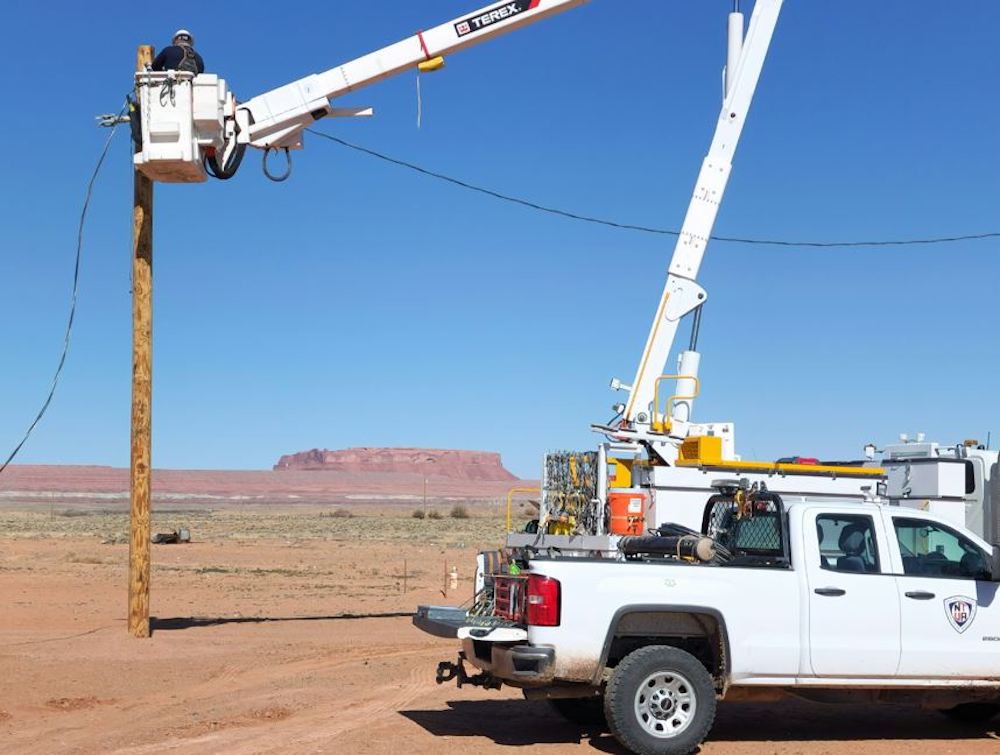
- Details
- By Chez Oxendine
- Energy | Environment
The Bureau of Indian Affairs has announced the first round of funding under its Tribal Electrification Program, awarding $72 million to 21 tribes to connect homes to renewable or zero-emissions energy systems.
The TEP, which first announced a funding opportunity in August 2023, will provide grant awards and technical assistance to each tribe as they connect unelectrified homes. The money, allocated under 2022’s Inflation Reduction Act, will also pay for repairs and retrofitting necessary to bring each home onto zero-emissions energy systems.
All told, the money will impact 9,595 homes: 881 homes are being retrofitted for energy efficiency, 991 homes will be newly electrified, and 7,716 homes will transition to clean energy systems, according to a Department of Interior representative.
“Indian Country’s revitalization and future depends on Tribal households, schools and businesses having access to clean, reliable power,” Assistant Secretary for Indian Affairs Bryan Newland told Tribal Business News. “The Tribal Electrification Program is important for providing Tribes a much-needed boost to their efforts of closing the access-to-electricity gap in their communities.”
The Navajo Nation’s tribal utility authority will receive $10 million under the TEP grant program, according to the BIA. The funding will help connect around 250 homes on the Navajo reservation — that’s out of roughly 13,000 families on the reservation currently without power, according to Navajo Tribal Utility Authority Spokesperson Deenise Becenti.
“Anything helps,” Becenti said. “We're a not-for-profit tribal enterprise, so these allocations will help us fulfill dreams and answer prayers for families that have been waiting years, even decades for electric power.”
BIA’s Newland conceded that the need for energy funding in Indian Country outstripped the increased level of federal resources available, due partly to the sheer amount of work and cost necessary to bring even one house online. This round of grants and a second TEP funding opportunity this spring can “put a dent” in the energy gap, he said.
“The need is obviously much greater, because there's a lot of work that has to be done to even get home in a condition where they can be powered,” Newland said. “A lot of homes don't have wiring built in, and so you've got to do that work and you've got to plan on how to do this stuff. This funding isn't nothing, this is huge.”
The money is the latest in a federal surge of dollars aimed at electrifying Indian Country, following up on more than $400 million in energy funding announced last week during the Department of Energy’s Tribal Clean Energy Summit in Temecula, California. The renewed interest in Indian energy comes at a time when more than 16,000 homes on Native reservations remain disconnected, per a 2022 Office of Indian Energy report.
The awarded grants include:
- Levelock Village, Alaska - $333,813
- Kootznoowoo, Incorporated, Alaska - $500,000
- Chickaloon Native Village, Alaska - $7,767,520
- Tanana Chiefs Conference, Alaska - $9,922,060
- San Carlos Apache Tribe, Arizona - $360,000
- Hopi Utilities Corporation, Arizona - $4,200,000
- Navajo Tribal Utility Authority Arizona, New Mexico and Utah - $10,000,000
- Cachil Dehe Band of Wintun Indians, Colusa Rancheria, California - $250,000
- Santa Rosa Band of Cahuilla Indians, California - $250,000
- Yurok Tribe, California - $3,271,068
- Guidiville Rancheria of California - $3,552,350
- Shoshone Paiute Tribes, Idaho and Nevada - $525,000
- Prairie Band Potawatomi Nation, Kansas - $305,000
- Iowa Tribe of Kansas and Nebraska, Kansas - $9,400,000
- Bois Forte Band of Chippewa, Minnesota - $295,000
- Prairie Island Indian Community, Minnesota - $500,000
- Red Lake Band of Chippewa Indians, Minnesota - $600,000
- Pueblo of Santa Ana, New Mexico - $14,500,000
- Rosebud Sioux Tribe, South Dakota - $1,000,000
- Quinault Indian Nation, Washington- $3,650,000
- Eastern Shoshone Housing Authority, Wyoming - $1,000,000
In a statement, Interior Secretary Deb Haaland said the TEP was a “much-needed” program that was part of a greater effort by the federal government to support tribal energy.
“Every home deserves to have access to reliable, affordable electricity – and now, with historic investments from President Biden’s Investing in America agenda, we’re bringing much-needed resources to Indian Country to electrify homes with abundant clean energy sources,” Haaland said.
